Ice caves of the Apostles
Near Cornucopia, people wait for the window into a crystalline world to open.

© Beth Gauper
Along the Apostle Islands National Lakeshore in Wisconsin, everyone waits for a big freeze.
Only when temperatures stay low for a long time will the edges of Lake Superior freeze enough for people to walk out to the mainland ice caves, whose beauty is renowned.
Even when ice is sufficiently solid, wind may suddenly split it, and snow may block the access drive. So when park rangers say it's okay to go — well, then you'd better go.
In recent years, warm weather and/or winds have kept cave access closed. In 2015, it opened Feb. 28, and in 2014 it opened unusually early, on Jan. 15.
It's usually late February when callers to the ice-cave hot line hear those magic words: "Conditions do allow access to the mainland sea caves."
The first year I saw them, it was the first day of March when I drove four miles from Cornucopia to Meyers Road, parked near the lakeshore and started picking my way over the lumpy path across the frozen lake.
The whole world was white, except for the frosty blue of the sky, and it was hard to tell where lake ended and shore began — especially since a 4-foot-high wall of snowy boulders sat where I thought the lake should be.
Then I passed Craig Mealman of nearby Russell Township, who explained that the "boulders" were blocks of ice pushed toward the shore by wind.
Mealman had just been to the caves and was planning to return the next week with a picnic.
"There are a few areas where I'd just like to sit and look at it," he said. "You can sit and take in the awe of it. In one place, it looks just like a crystal geode on the inside; it's cool."
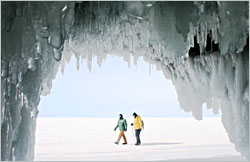
© Beth Gauper
The ice is formed by lake spray and by water trickling over and between layers of the red sandstone cliffs, which rise 50 to 80 feet above the lake. Ice formations also can be found in the sea caves at Swallow Point on Sand Island and on the north shore of Devil's Island.
But it's rare to gain access to those caves, unlike the ones that line the bay called Mawikwe, Ojibwe for weeping woman.
Delicately colored by minerals in the rock and soil, frozen to the cliffs in ways that mimic the stalactites, columns and flowstone found in underground caves, the ice formations are spectacular — and irresistible to photographers.
As the sun began to settle toward the horizon, I reached the caves and found that all three others there were professional photographers, busily adding ice-cave shots to their stock.
I walked closer to the caves and skidded; snowshoes aren't much good on glass. An infinite variety of ice covered the cliffs — smooth blue humps at the base, froths of mint-green blooming out of the middle and thin layers draped over the top, translucent as a centenarian's skin.
It was as if a limestone cave had been turned inside out and left to shimmer in the sun. There were colonies of chalk-white soda straws and bacon-strip flowstone.
Inside the caves, gnarled yellow columns formed rows of organ pipes, and stalactites hung like cow teats.
Outside, ice clung to rock in ridged waves, like fish scales, and the soda straws in some crevices were as thick as shag carpet.
All this ice is just a bonus, though, for the cliffs are spectacular in themselves. Over eons, the waves of Lake Superior have cut arches and chambers in this red sandstone, with shadowy interiors connected by skeletal fingers of rock.
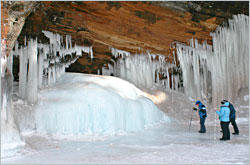
© Beth Gauper
Topped by spindly birch trees, white and black against the winter sky, they're breathtaking.
Soon the light began to fade, and I ducked into a cave one last time, looking through a fringe of icicles at the red sun sitting on the horizon, amid bands of pink.
The photographers went on to other landscapes, and I went into Cornucopia to have dinner at Fish Lipps, a cheerful place with colored lights and booths lined by windows.
As I waited for my mushroom-Swiss burger, I talked with local T.J. Lovick. He told me why the park rangers are so conservative about allowing cave access.
"That lake can split just like that," he said. "You get wind surges, and it moves the ice back and forth. One day the lake is white, and the next day it's open as far as you can see. It can happen in two hours."
Often, he said, people stop by the restaurant asking for directions to the caves.
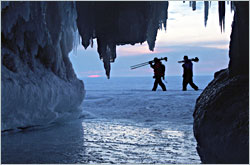
© Beth Gauper
"We have a lot of people come in and ask for directions in December and January," he said. "Their local lakes are frozen, and they think this is a regular lake." He laughed uproariously.
Cornucopia, a fishing village since the 1920s, is the northernmost town in Wisconsin. Today, it's a friendly, laid-back spot with a marina that caters to sailors and a few gift shops that snag tourists who happen by.
Many kayakers visit the sea caves in summer, but if you don't have your own kayak, you'll need to rent one, and to do that, you'll need to show you've completed a safety course.
In winter, all it takes to get to the caves is a pair of legs.
As I headed home, park rangers at the Bayfield headquarters were bracing for an onslaught of visitors. It was the first weekend people would be able to get to the caves, and the first winter in years that the ice had frozen for more than a few days.
"The lake is a huge heat sink, and it takes a long time for that heat to dissipate," said Neil Howk, the ranger whose voice I had heard so often on the hot line. "It takes a long time for the ice to get going."
Rangers regularly check the ice with augers, he said, but still get nervous, especially with thousands of people going out on a weekend.
"We don't say it's safe to go out on the ice any time, because that's stupid," Howk said. "Ice is not safe. Basically, our message is, conditions do allow access."
But on the Apostle Islands lakeshore, those are magic words.
Trip Tips: Cornucopia and Mawikwe Bay ice caves
Information: For current conditions, call the Apostle Islands National Lakeshore ice-caves hot line, 715-779-3397, Ext. 3. Or check the Facebook page.
The park service charges a $5-per-person fee to visit the caves, or a $10 annual pass. Bring cash. There's no charge for children up to age 15.
Getting there: It's a good hour east of Duluth. From there, take U.S. 2/53 to Wisconsin 13 and Cornucopia, whose "downtown" is just off Wisconsin 13 on Superior Avenue.
It's another four miles to the parking lot off Meyers Road. From there, it's a mile walk east to the ice caves.
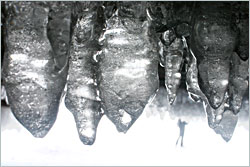
© Beth Gauper
What to take: Wear crampons on your boots and carry ski or hiking poles, because the lake surface is sheer ice.
Wear warm clothes, including something to cover the face. It's windy on the open lake.
When to go: Snow insulates the ice and delays a hard freeze; the best scenario is extreme cold, no snow and no wind. Usually, it's fruitless to check before mid-February.
The year 2014, however, was very unusual. Rangers gave the okay on Jan. 15, the earliest date in most people's memories. And in 2009, park rangers gave the okay on Jan. 29 and conditions allowed visits all the way through mid-March.
The caves are most beautiful in late afternoon, when the setting sun illuminates the ice and stone, and during extreme cold, when ice is most delicately formed. Try to go on weekdays to avoid crowds.
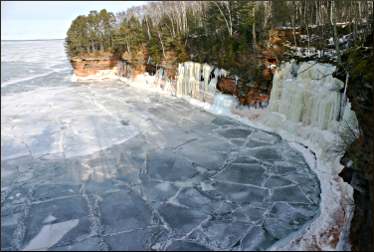
© Beth Gauper
Obviously, don't go at all unless rangers give the green light. If snow has been heavy, call and ask if Meyers Road is plowed.
If you want to see the ice caves but can't get to them on the lake, you can walk to them on the two-mile Lakeshore Trail, which starts at Meyers Beach and follows the clifftop (be careful).
You won't get to go into the caves, but you'll see lovely blue and ocher icefalls over the red cliffs. The patterns of lake ice also are beautiful when viewed from above.
What to take: Wear sturdy boots and, unless the lake path is packed, snowshoes. Boot crampons are handy for climbing around inside the caves.
To be especially safe, keep a buddy nearby and carry ski poles in case the ice breaks and to help keep your balance on the ice.
Dining: The Fat Radish serves soups, salads and sandwiches in the former Village Inn.
Accommodations: The Fo'c'sle B&B has two attractive rooms with private entrance, overlooking Siskiwit Bay Marina; breakfast is brought to the door. Dave and Mary Beth Tillmans are the owners.
Also on the bay, Siskiwit Bay Lodge offers a suite and three rooms.
There are many more places to stay in and around Bayfield.
For more, see Bayfield in winter.